First we stopped at Bandelier National Monument. Not knowing what to expect, we were astounded by the gorgeous light-colored canyon walls against a deep blue sky. Even better, the walls are naturally swiss-cheesy, and hundreds of years ago, Pueblo Indians enlarged many of the holes, building homes right into the cliffs. Over time, as they cultivated crops, they migrated from the cliffs into the bottom of Frijoles Canyon and built villages there as well.
There’s a short two-mile hike right from the visitors center. The rangers say it takes 1.5 hours, which seemed really slow to us. We wound up taking 2.5 hours! There was just so much to see! Like the gorgeous bright yellow of the fall colors in Frijoles Canyon:
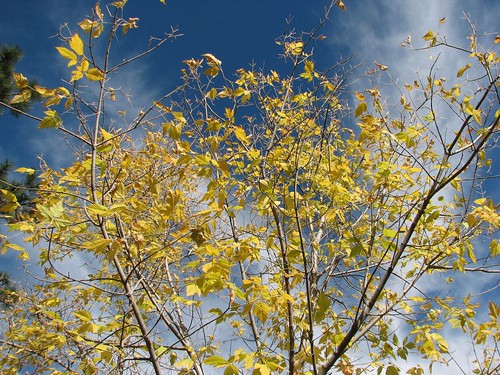
And the beautiful cliffs on the side of the canyon:
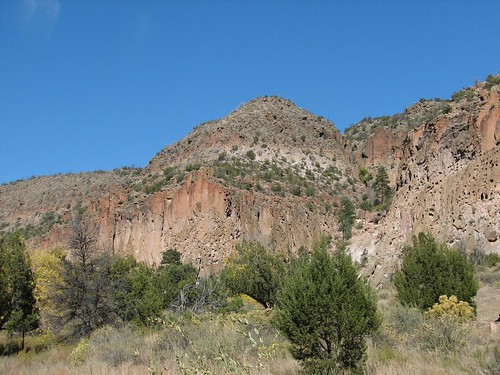
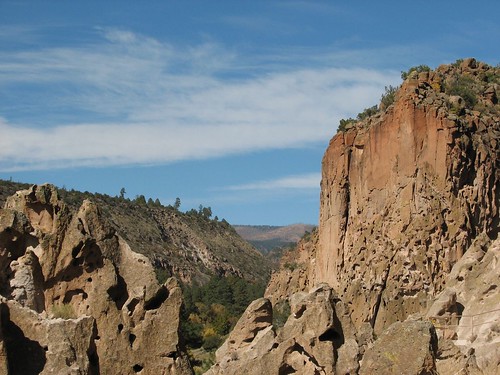
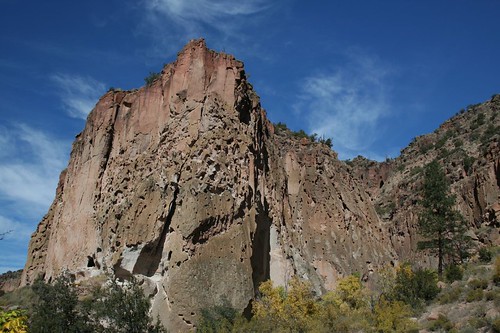
Here’s the living area in the middle of the canyon:

And this is looking over a partially rebuilt kiva – an underground hut used for ceremonial purposes:
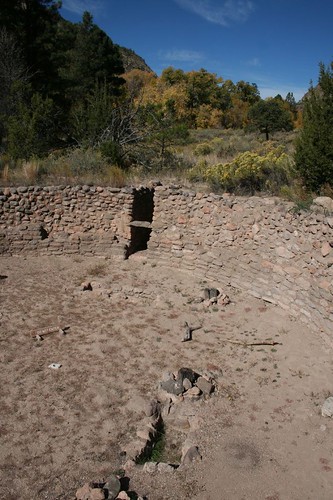
Here’s Brian inside a cliff house called the Long House. All of the rooms had smoke-covered ceilings. Apparently, smoking the ceilings stabilizes them, making them less likely to cave in. The Park Service still regularly smokes the ceilings of the cliff rooms along the hiking trails.
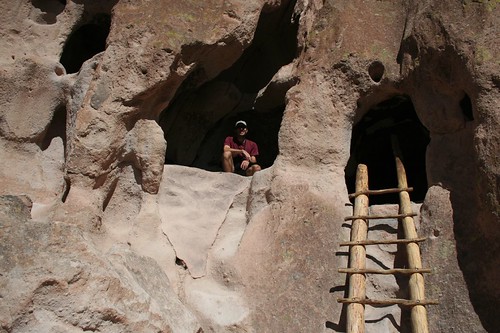
The last section of the hike led to the Alcove House. The ascent to the Alcove House required climbing four ladders and wasn’t recommended for people prone to vertigo or with heart or respiratory problems, and indeed we saw a few people who had chosen to stay at the bottom. It really was a bit frightening – one slip would mean a long fall. Here’s one of the ladders:

And here’s Brian, pretending to look brave:

Inside the Alcove House was another kiva that you could climb down into, via yet another ladder, so Brian took a picture of Sarah from inside the kiva:
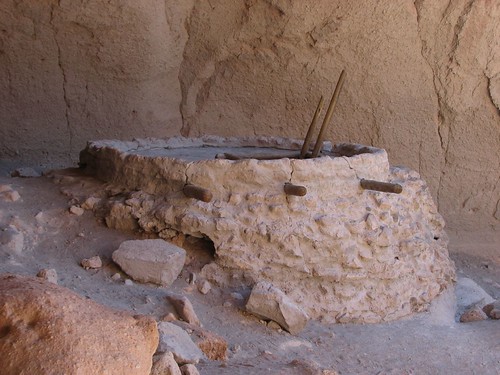
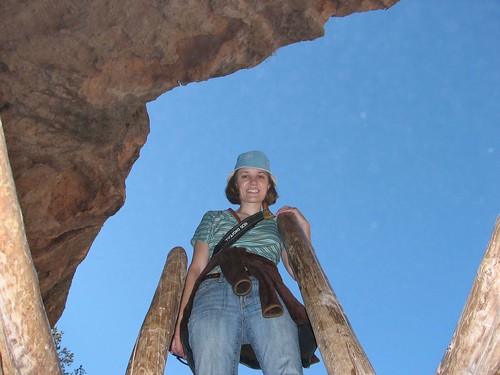
When we got back to the visitors center, the parking lot was entirely full and people were using the picnic area as overflow parking. This was one popular place! Apparently, 350,000 people visit annually – respectable for a national park, let alone a national monument.
There were several other great-sounding trails in the park, and we briefly considered staying longer as we ate lunch at a picnic table in the campground, but decided to move on because there was still so much to see.
Next stop was Los Alamos. We visited the Los Alamos Historical Museum and got sucked in for a long time, looking over the displays of prehistoric people, the ranch / boys school that occupied the area in the 1930s, and finally the secret city that replaced the ranch where the atomic bomb was developed. An inscription referred to New Mexico as the home of the earliest recorded human life in North America (the artifacts of the Clovis people have been dated back to around 12,000 B.C.) and the breeding ground for technology that could be the end of human life.
After reading a recommendation in our “Let’s Go U.S.A.” travel guide, we visited the Black Hole, a place that could legitimately be described as a store, a museum, or a junkyard – it’s all of these. It’s where equipment from Los Alamos National Labs goes to rest – everything from oscillopes to monstrous hard drives that hold kilobytes of data to computer monitors with images of software programs permanently burned onto their screens. The junk fills the store, which is really a large warehouse-like building, along with a large swath of pavement out in front. When we marveled at the sheer volume of junk, a helpful employee informed us that junk also filled an additional warehouse, the owner’s house, the employee’s house, the church next door, and more. Wow!
Just like in the Black Canyon of the Gunnison, photos can’t do justice to the sheer enormity of the place, but here’s a sampling anyway:


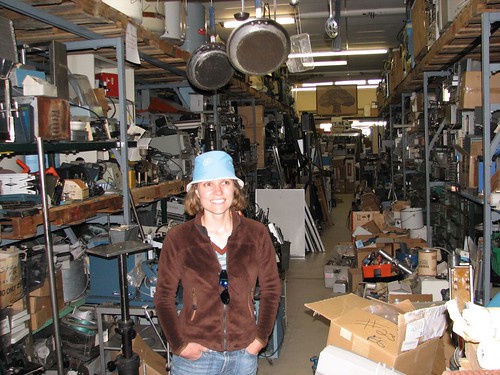
Just as we were leaving, an old man came up to us and started chatting. His name was Ed Grothus, and he was wearing purple camo pants, a white button-down shirt with Native American jewelry, and a Lacoste button-down cardigan. He said that he was the owner of the place, and when we complimented him on what he calls his “atomic waste” that populates every nook and cranny of his store, he told us we hadn’t seen anything yet. He took us outside to one of two side-by-side shipping containers. The shipping container was filled, end to end, by a single, massive block of marble. As he described it to us, we learned that it was a white marble obelisk, over 30 feet long and weighing 22 tons. There was an identical obelisk in the adjacent shipping container. Both obelisks were inscribed, in 16 languages, with a message commemorating the atomic bomb and warning against the dangers of nuclear power. “No one is safe unless everyone is safe,” he says, calling Bush’s homeland security platform, securing the U.S. against the evils outside our borders, shortsighted.
On top of each of the obelisks would sit a large black marble ball, and each obelisk would stand on and be surrounded by black marble cubes that Ed called Doomsday Stones. As he continued talking, we learned that he had worked for 20 years contributing to the advancement of nuclear weaponry – although he didn’t say it, you could surmise that the Doomsday Stones and obelisks were his attempt at atonement for the sins he perceived.
He took a trip to China and found out that he could have the monument built for just $150,000 delivered, which seemed like an amazing bargain to him. So he sold a property that he owned and had been renting out, commissioned the monument and had it built. Now the obelisks are in Los Alamos in the shipping container outside the Black Hole, and the balls and Doomsday Stones are still being constructed in China. He’s been lobbying for years to have the monument prominently displayed in Los Alamos or perhaps even in the state capital of Santa Fe, but so far, no luck. So the obelisks continue to sit in their shipping containers, and Ed tells his story to interested tourists several times a day.
A 22-ton piece of marble inside a shipping container is another thing that’s hard to capture in a photo, but here it is:
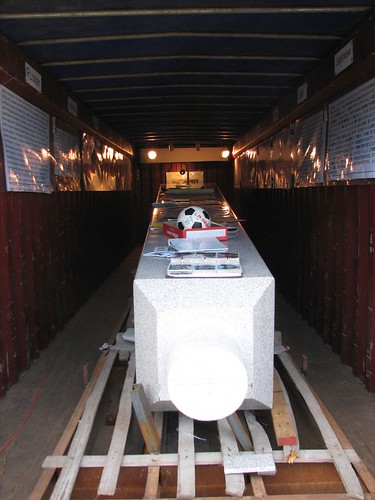
And here’s Ed with the balls that will top the obelisks:
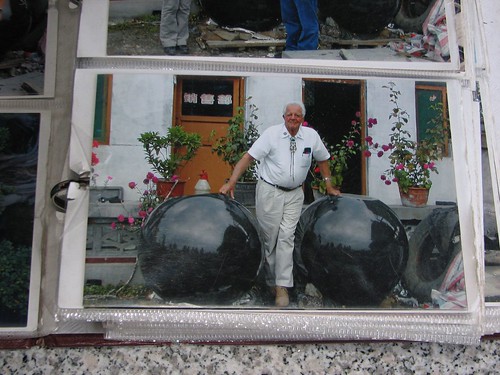
After this strange and wonderful encounter, we continued on to Santa Fe. We tried to watch Game 6 of the Red Sox and Indians series, but by the time we found a sports bar it was the third inning and the Red Sox were already winning 10-1. We stocked up on groceries at Trader Joe’s – the last Trader Joe’s we would see for a while, since there are none in Texas – and headed back to our campground. We were camped in a Forest Service campground called Black Canyon, eight miles outside town. We found a site with a driveway that was so steep that it had a sign indicating it wasn’t recommended for RVs, so we took it and had a very nice spot atop a hill.
The next day we toured Santa Fe’s museums. We got a fantastic parking spot, right outside the St. Francis Cathedral that looks over the historic district:

Then we visited the Palace of the Governors, the oldest public building in the U.S. It was built in 1610 and has been the home of dozens of governors during New Mexico’s history, most of them Spanish. Now it’s a history and culture museum. It included a display of Hispanic religious art that ranged from displays in people’s homes to spray-painted religious scenes on the hoods of low-rider cars.
Then we visited the Museum of Fine Arts, which included a display of Georgia O’Keefe’s art. We were curious to see it, but decided that we didn’t really like it – a bit too abstract.
We ended with the Museum of International Folk Art, which was holding a Day of the Dead celebration. Kids could decorate sugar skulls, so we did. It’s a skull made of sugar that you decorate with multiple colors of frosting, putting eyes on it, a mustache, a pirate’s cap, and so on. It was lots of fun. You’re supposed to eat them afterwards, but we weren’t so confident in the cleanliness of the frosting, so we passed. A mariachi band was playing, too, and we sat and listened to them for a while.
The centerpiece of the museum is an international collection of toys donated by a man named Girard, who collected them over many years during his travels. The collection that he donated numbers over 100,000 items, and roughly 10,000 are on display in a busy, wild room that places items everywhere from well below eye level to the ceiling and might whimsically juxtapose dolls from, say, Poland and Nigeria in the same display case – you could spend days in this one room and not see it all. As it was, we spent several hours right up until closing and as a result, missed the rest of the museum. Photos aren’t allowed in the museums, so we don’t have any pictures to show, except for this mailbox dressed up as R2-D2 that we found on the street:
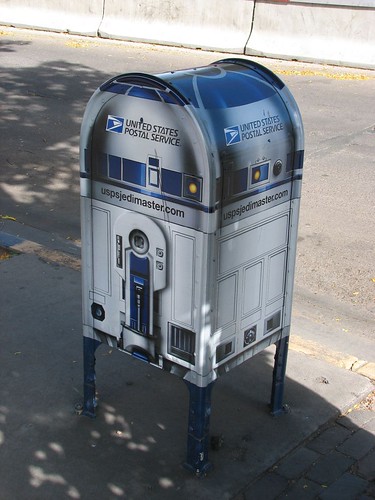
We found a public park to cook our dinner and then went to the Catamount bar to watch Game 7 of the American League Championship Series. Unfortunately, Sunday night football was on at the same time, a game between the Broncos and Steelers that was of more interest to the crowd of mostly locals than the baseball game. But after we sat down in front of the big screen with our beer and water, folks gradually trickled in, most rooting for the Indians, it seemed. So it was satisfying when the Red Sox won 11-2 to make it to the World Series.
Afterwards, we returned to our RV-proof site in the Black Canyon campground to find a layer of snow on our tent! It had been chilly all day, a good day for museum hopping, baseball watching and beer drinking, but we didn’t expect snow. Fortunately, we’d eaten dinner much earlier, so we didn’t have to do anything but bundle up, snuggle up in our sleeping bags, and go to sleep.
Next, Albuquerque!
No comments:
Post a Comment